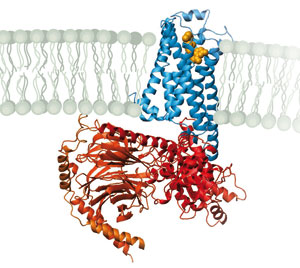The Royal Swedish Academy of Sciences has decided to award the Nobel Prize in Chemistry for 2012 to Robert J. Lefkowitz, Howard Hughes Medical Institute and Duke University Medical Center, Durham, NC, USA, and Brian K. Kobilka, Stanford University School of Medicine, Stanford, CA, USA
“for studies of G-protein–coupled receptors”.
Smart receptors on cell surfaces
Your body is a fine-tuned system of interactions between billions of cells. Each cell has tiny receptors that enable it to sense its environment, so it can adapt to new situations. Robert Lefkowitz and Brian Kobilka are awarded the 2012 Nobel Prize in Chemistry for groundbreaking discoveries that reveal the inner workings of an important family of such receptors: G-protein–coupled receptors.

For a long time, it remained a mystery how cells could sense their environment. Scientists knew that hormones such as adrenalin had powerful effects: increasing blood pressure and making the heart beat faster. They suspected that cell surfaces contained some kind of recipient for hormones. But what these receptors actually consisted of and how they worked remained obscured for most of the 20th Century.
Lefkowitz started to use radioactivity in 1968 in order to trace cells’ receptors. He attached an iodine isotope to various hormones, and thanks to the radiation, he managed to unveil several receptors, among those a receptor for adrenalin: beta-adrenergic receptor. His team of researchers extracted the receptor from its hiding place in the cell wall and gained an initial understanding of how it works.
The team achieved its next big step during the 1980s. The newly recruited Kobilka accepted the challenge to isolate the gene that codes for the beta-adrenergic receptor from the gigantic human genome. His creative approach allowed him to attain his goal. When the researchers analyzed the gene, they discovered that the receptor was similar to one in the eye that captures light. They realized that there is a whole family of receptors that look alike and function in the same manner.
Today this family is referred to as G-protein–coupled receptors. About a thousand genes code for such receptors, for example, for light, flavour, odour, adrenalin, histamine, dopamine and serotonin. About half of all medications achieve their effect through G-protein–coupled receptors.
The studies by Lefkowitz and Kobilka are crucial for understanding how G-protein–coupled receptors function. Furthermore, in 2011, Kobilka achieved another break-through; he and his research team captured an image of the beta-adrenergic receptor at the exact moment that it is activated by a hormone and sends a signal into the cell. This image is a molecular masterpiece – the result of decades of research.
Robert J. Lefkowitz, U.S. citizen. Born 1943 in New York, NY, USA. M.D. 1966 from Columbia University, New York, NY, USA. Investigator, Howard Hughes Medical Institute. James B. Duke Professor of Medicine, and Professor of Biochemistry, Duke University Medical Center, Durham, NC, USA.
Brian K. Kobilka, U.S. citizen. Born 1955 in Little Falls, MN, USA. M.D. 1981 from Yale University School of Medicine, New Haven, CT, USA. Professor, Chair of molecular and cellular physiology and Hélène Irwin Fagan Chair in Cardiology, Stanford University School of Medicine, Stanford, CA, USA. Stanford University School of Medicine, Stanford, CA, USA.
Prize amount: SEK 8 million, to be shared equally between the Laureates.
The Royal Swedish Academy of Sciences, founded in 1739, is an independent organization whose overall objective is to promote the sciences and strengthen their influence in society. The Academy takes special responsibility for the natural sciences and mathematics, but endeavours to promote the exchange of ideas between various disciplines.
Nobel Prize® and the Nobel Prize® medal design mark are registered trademarks of the Nobel Foundation.
More information
The Laureates
Robert J. Lefkowitz, Lefkowitz lab
Brian K. Kobilka, Kobilka lab
Lectures (video)
Lefkowitz, R. J. (2010) Part 1 Seven Transmembrane Receptors
Lefkowitz, R. J. (2010) Part 2 Beta-arrestins
Articles
Buchen, L. (2011) Cell signalling caught in the act, Nature 475:273–274.
Buchen, L. (2011) It’s all about the structure, Nature 476:387–390.
Snyderman, R. (2011) Introduction of Robert J. Lefkowitz, J. Clin. Invest. 121(10):4192–4200.
Williams, R. (2010) Robert Lefkowitz: Godfather of G Protein-Coupled Receptors, Circ. Res. 106:812–814.